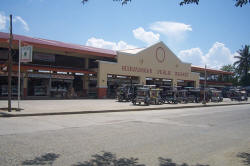|
 The Guinayangan Public Market is owned, operated and maintained by the Municipal
Government.
At present it is under the Office of the Economic
Enterprise which is under the Office of the Municipal Mayor. The
stallholders or Vendors only rent for the space they are occupying for a period of time
indicated in the lease contract they signed. Rentals vary from size
and location of the stalls. Income received from the rentals are used for the maintenance and
improvements of the market as well as the annual
amortization of the loan to MDFO-LOGOFIND who financed the
construction of the public market. The designated public market administrator oversees the daily operations of
the market. All vendors are bound by the set of rules and regulations set by the Municipality.
The municipal government is proposing for the transfer of some of
the maintenance operations of the public market to the Guinayangan
Public Market Vendors Association which includes among others the
operation and maintenance of the comfort rooms. the public paging
system, and the price monitoring display board. The Guinayangan Public Market is owned, operated and maintained by the Municipal
Government.
At present it is under the Office of the Economic
Enterprise which is under the Office of the Municipal Mayor. The
stallholders or Vendors only rent for the space they are occupying for a period of time
indicated in the lease contract they signed. Rentals vary from size
and location of the stalls. Income received from the rentals are used for the maintenance and
improvements of the market as well as the annual
amortization of the loan to MDFO-LOGOFIND who financed the
construction of the public market. The designated public market administrator oversees the daily operations of
the market. All vendors are bound by the set of rules and regulations set by the Municipality.
The municipal government is proposing for the transfer of some of
the maintenance operations of the public market to the Guinayangan
Public Market Vendors Association which includes among others the
operation and maintenance of the comfort rooms. the public paging
system, and the price monitoring display board.
PROCEDURES
FOR RENTING A STALL OR SPACE
-
Check with the designated Market
Administrator or the Municipal Treasurer
for vacant stall in the market.
-
Fill up the
application form (P 50.00
filing fee) providing information on
what kind of commodities to be sold for
proper sectioning. One can select
on the following sections of the market:
1. FISH
SECTION – refers to the area where only fresh fish, clams,
crabs, seaweeds
and other sea foods and marine products are sold.
-
MEAT SECTION – refers to the area
where all kinds of meat such as beef,
pork, chicken, and other meat products
are sold.
-
DRIED FISH SECTION – refers
to the area where all kinds of
processed/dried fish and other
marine products are sold.
-
DRY GOODS SECTION – refers to
the area where all kinds of
textiles, ready made dresses and
toiletries, footwears, kitchen
wares, utensils and other household
articles, plastics and leather
products, school and office
supplies are sold .
-
GROCERY/HANDICRAFT SECTION –
refers to the area where all kinds
of bakery products, confectioneries
, beverages/soft drinks, and the
like, canned goods, eggs, sausages,
starch, salt, soap and other
household and food products
including native products are sold.
-
RICE/GRAIN SECTION – refers
to the area where only rice and
other grain cereals are sold.
-
FRUITS AND VEGETABLE SECTION
– refers to the area where all kinds
of fruits and vegetable including
coconut and root crops are being
sold.
-
EATERY (COMMERCIAL) SECTION –
refers to the area where only all
kinds of cooked/prepared food are
sol . This includes refreshment
parlors, cafeterias and kitchenette.
-
VETERINARY & AGRICULTURAL SECTION
– refers to the area where poultry
supply and other agricultural
products and supplies are sold.
-
GENERAL BUSINESS (COMMERCIAL)
SECTION – refers to the area
where only drug stores, tailoring
shops, barbers shops, electronic
shops are located.
-
MISCELLANEOUS SECTION –
refers to the area where any other
business not classified herein above
shall be allowed including firewood,
charcoal and other minor facilities
3.
Ask for the
Certificate of Award of Stall.
4.
Pay the 50% of the Stall Rights Fee at the Treasury Office.
5.
Sign the
Contract of Lease of Stall.
6.
If an improvement will be done in the leased stall, ask for the Form
for
Request for Improvement. Fill it up and process it for
approval by the Municipal Mayor.
7.
Provide improvement to your leased stall, if any.
8. Pay
25% of the Stall Rights Fee.
9. Ask
for the
Certificate of Occupancy.
10.
Start your business.
11.
After the sixth month of operation of your business, apply and
process the approval of your Business Permit and Licenses.
SCHEDULE OF STALL RIGHTS
FEE
Stall Rights Fee is at the
rate of P 2,000.00 per square meter payable in the
following schedule
a. 50% upon filing of application
for lease of stall
b. 25% upon occupancy
c. the remaining 25% will be paid in 6
equal monthly amortization.
SCHEDULE
OF RENTAL
Rental Fee of
Stalls is payable daily at the rate of
P 3.00/square meter/day for
inside stalls
P 3.50/square meter/day for
outside stalls and stalls within the main alley
P 3.25/square meter/day for
outside stalls at the back of the market main
building
P 40.00/stall/day at the meat
section
P 20.00/stall/day at the fish
section
|

